Joseph Smith Hypocephalus
The Joseph Smith Hypocephalus (also known as the Hypocephalus of Sheshonq)[lower-alpha 1] was a papyrus fragment, part of a larger collection of papyri known as the Joseph Smith Papyri, found in the Gurneh area of Thebes, Egypt, around the year 1818.[1] The owner's name, Sheshonq, is found in the hieroglyphic text on said hypocephalus. Three hypocephali in the British Museum (37909, 8445c, and 8445f) are similar to the Joseph Smith Hypocephalus both in layout and text and were also found in Thebes.[1]
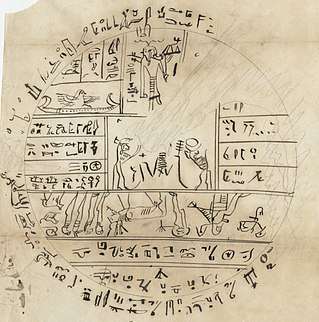
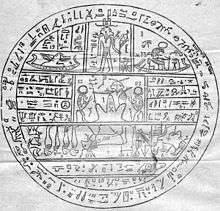
A woodcut image of the hypocephalus was initially published on March 15, 1842, in Volume III, No. 10 of the Latter Day Saint newspaper Times and Seasons, two years before the death of Joseph Smith, who was the editor of the Times and Seasons. This image is included as one of several appendices to the Book of Abraham, where it is called Facsimile No. 2. The Book of Abraham has been considered scripture by members of The Church of Jesus Christ of Latter-day Saints (LDS Church) since 1880. The location of the original document is unknown.
Hypocephali
Hypocephali are small disk-shaped objects, generally made of stuccoed linen,[2] but also of papyrus,[3] bronze, gold, wood, or clay, which ancient Egyptians from the Late Period onwards placed under the heads of their dead.
They were believed to protect the deceased, causing the head and body to be enveloped in light and warmth, thereby making the deceased divine.[4] Hypocephali symbolized the Eye of Ra (later the Eye of Horus), which represented the sun, and the scenes portrayed on them relate to Egyptian ideas of resurrection and life after death, connecting them with the Osirian resurrection myth.[5]
To the ancient Egyptians, the daily setting and rising of the sun was a symbol of death and rebirth. The hypocephalus represented all that the sun encircles — the world of the living, over which it passed during the day, was depicted in the upper half, and that of the dead, which it crossed during the night, in the lower portion.[6]
They were part of the burial materials created by Egyptians from the Twenty-sixth Dynasty onward. [2] Chapter 162 of the Book of the Dead version of that period contain directions for the making and use of hypocephali.[7]
Within the large circle of hypocephali are compartments containing hieroglyphic text and figures which are extracts from Chapter CLXII of the Egyptian Book of the Dead.[8] P. J. de Horrack stated that the scenes portrayed in hypocephali relate in all their details to the resurrection and the renewed birth after death...symbolized by the course of the Sun, the living image of divine generation. The circle is divided to represent two celestial hemispheres and the cycle of renewal.
Lacunae and reconstructions
As stated by LDS Egyptologist Michael D. Rhodes:
A careful examination of Facsimile No. 2 shows that there is a difference between most of the hieroglyphic signs and the signs on the right third of the figure on the outer edge as well as the outer portions of the sections numbered 12–15. These signs are Hieratic, not hieroglyphic, and are inverted, or upside down, to the rest of the text. In fact, they are a fairly accurate copy of lines 2, 3, and 4 of the Joseph Smith Papyrus XI, which contains a portion of the Book of Breathings. Especially clear is the word snsn, in section 14, and part of the name of the mother of the owner of the papyrus, (tay-)uby.t, repeated twice on the outer edge. An ink drawing of the hypocephalus in the Church Historian's office shows these same areas as being blank. It is likely that these portions were destroyed on the original hypocephalus and someone (the engraver, one of Joseph Smith's associates, or Joseph himself) copied the lines from the Book of Breathings papyrus for aesthetic purposes.[1]
Interpretation of images (Figures No. 1-7, 22-23)
There is still some ambiguity regarding how these Egyptian names and text may have been pronounced.[9]
The numbers labeling the figures were added to correspond to explanations of the images and text given by Joseph Smith.
Figure No. 1
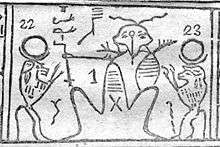
Figure 1 has been described as the god Re-Atum, typically depicted with four heads. The original copy is missing the head portion of this figure, and it is possible Smith copied the heads and shoulders of Figure 2.[10]
Left of center is the was scepter, or DJAM scepter.[11]
Joseph Smith explained figure 1 as;
Kolob, signifying the first creation, nearest to the celestial, or the residence of God. First in government, the last pertaining to the measurement of time. The measurement according to celestial time, which celestial time signifies one day to a cubit. One day in Kolob is equal to a thousand years according to the measurement of this earth, which is called by the Egyptians Jah-oh-eh.[12]
Figures No. 22 and 23
Figures 22 and 23 are apes with lunar disks appearing above their heads.[10]
Joseph Smith explained figures 22 and 23 as: "the medium of Kli-flos-is-es, or Hah-ko-kau-beam, the stars represented by numbers (figures) 22 and 23, receiving light from the revolutions of Kolob."[12]
Figure No. 2
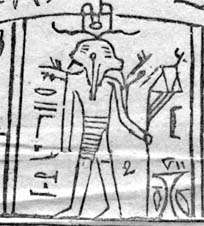
On this shoulders are jackal heads. In his left hand is the staff of Wepwawet. The figure to the right was not present in the damaged original.[10]
Joseph Smith stated that this figure;
Stands next to Kolob, called by the Egyptians Oliblish, which is the next grand governing creation near to the celestial or the place where God resides; holding the key of power also, pertaining to other planets; as revealed from God to Abraham, as he offered sacrifice upon an altar, which he had built unto the Lord.[12]
Michael D. Rhodes identified the hieroglyphs to below as: "The name of this Mighty God."
| "The name of this Mighty God."[13] in hieroglyphs |
|---|
Figure No. 3
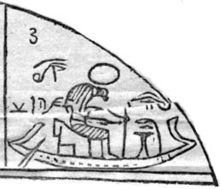
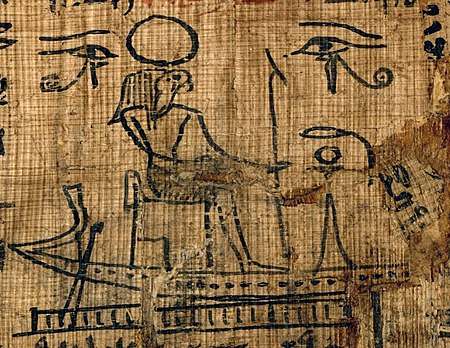
Figure 3 is located in the missing section of the hypocephalus. Prior to printing, the section was filled in. The text on the rim surrounding the figure has been replaced by text from the unrelated Breathing Permit of Hôr.[14] Similarly, figure 3 is also foreign to the hypocephalus. As Hugh Nibley noted, "The boat in the picture is identical with another piece of Joseph Smith Papyrus, namely JSP IV, which accompanies chapter 101 of the Book of the Dead."[14] Despite the striking resemblance, Nibley and some other apologists feel that the boat is inspired, because boats sometimes do appear in that section on hypocephali. Egyptologists dispute this, arguing that just like the surrounding text, the inclusion by Joseph Smith (or his engravers) is irrelevant.[10]
Also on the barque is an offering stand. The two characters farthest to the left may be an attempt to engrave dp.t ntr, which would translate as "Divine Ship":[13]
Joseph Smith's interpretation:
Is made to represent God, sitting upon his throne, clothed with power and authority; with a crown of eternal light upon his head; representing also the grand Key-words of the Holy Priesthood, as revealed to Adam in the Garden of Eden, as also to Seth, Noah, Melchizedek, Abraham, and all to whom the Priesthood was revealed.[12]
Figure No. 4

A falcon, representing Sokar[1][10] sitting on a mummy case, with outstreatched wings, sitting upon a papyrus boat. The Coffin Texts state; "He takes the ship of 1000 cubits from end to end and he sails it to the stairway of fire."[1]
Joseph Smith's interpretation:
Answers to the Hebrew word Raukeeyang, signifying expanse, or the firmament of the heavens; also a numerical figure, in Egyptian signifying one thousand; answering to the measuring of the time of Oliblish, which is equal with Kolob in its revolution and in its measuring of time.[12]
Figure No. 5
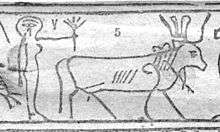
A cow, representing Hathor, the heavenly cow.[10] Behind is a standing female figure with the Eye of Horus depicted on her head and holding out a water lily in her left hand.[10]
Joseph Smith's interpretation:
Is called in Egyptian Enish-go-on-dosh; this is one of the governing planets also, and is said by the Egyptians to be the Sun, and to borrow its light from Kolob through the medium of Kae-e-vanrash, which is the grand Key, or, in other words, the governing power, which governs fifteen other fixed planets or stars, as also Floeese or the Moon, the Earth and the Sun in their annual revolutions. This planet receives its power through the medium of Kli-flos-is-es, or Hah-ko-kau-beam, the stars represented by numbers 22 and 23, receiving light from the revolutions of Kolob.[12]
Figure No. 6
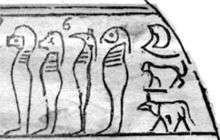
Four standing figures, representing the four sons of Horus.[10][1] They are the patron gods of the lungs, liver, stomach and intestines,[10] and were the gods of the four quarters of the earth.[1]
Joseph Smith's interpretation: "Represents this earth in its four quarters."[12]
Figure No. 7
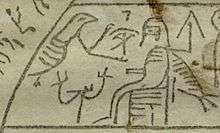
This figure has been identified with Min[1] or the god Amon.[10] To the left is a figure with a bird's head, presenting the Eye of Ra, identified as Nehebka or Nehebkau[10], a provider of life and nourishment.[1]
Joseph Smith's interpretation:
Represents God sitting upon his throne, revealing through the heavens the grand Key-words of the Priesthood; as, also, the sign of the Holy Ghost unto Abraham, in the form of a dove.[12]
Text to the left (Figures No. 8-11)
| Figure No. 11 |  Detail of Figure No. 11 |
"O god, sleeping in the time" |
|---|---|---|
| Figure No. 10 |  Detail of Figure No. 10 |
"of the beginning. Great God, Lord of Heaven and earth," |
| Figure No. 9 |  Detail of Figure No. 9 |
"and below the earth and of the waters" (Damaged in the original.) |
| Figure No. 8 |  Detail of Figure No. 8 |
"Grant that the Ba of Osiris Sheshonq live." |
Theodule Deveria gave the following translation: "O great God in Sekhem; O great God, Lord of heaven, earth and hell. ... Osiris S'es'enq."[15]
Michael D. Rhodes gives the following translation: "O God of the Sleeping Ones from the time of the creation. O Mighty God, Lord of heaven and earth, of the hereafter, and of his great waters, may the soul of the Osiris Shishaq be granted life."[1]
Robert K. Ritner gives the following translation: "O noble god from the beginning of time, great god, lord of heaven, earth, underworld, waters [and mountains,] cause the ba-spirit of the Osiris Sheshonq to live." (brackets and italics in original)[16]
Joseph Smith said of figure 8 in particular, "Contains writings that cannot be revealed unto the world; but is to be had in the Holy Temple of God."[12]
Text to the right (Figures No. 12-15)
| Figure No. 12 |  Detail of Figure No. 12 |
|---|---|
| Figure No. 13 |  Detail of Figure No. 13 |
| Figure No. 14 |  Detail of Figure No. 14 |
| Figure No. 15 |  Detail of Figure No. 15 |
The right portion of these characters are hieratic and appear to have been copied from Joseph Smith Papyrus XI.[13]
Included is sn-sn:[13]
Val Sederholm[17] has identified that the surviving traces of the original content parallel other hypocephali, and suggested the reading j nTr pfy 'A, 'nx m TAw, jw m mw: 'q r' jw [=r] sDm md.t=f. [Mj n] Wsjr, explaining that "the officiator, calling upon that special, particular, transcendent god, who lives by breathing, who negotiates the waters, pleads from the depths: May Re descend to hear Osiris' words! Come to Shoshenq, who is dead!"[18]
Text at the bottom (Figures No. 16-17)
 Detail of Figure No. 17 |
|---|
 Detail of Figure No. 16 |
| Figure No. 17: (h3t)tomb. (thy)desecration. (nn) strong negative. |
| Figure No. 16: "is not to be disturbed along with its Lord in the Duat forever." |
Michael D. Rhodes gives the following translation: "May this tomb never be desecrated, and may this soul and its lord never be desecrated in the hereafter."[1]
Robert K. Ritner gives the following translation: "Back, injury, back! There is none who attacks you. This ba-spirit and his lord will not be attacked in the underworld forever."[16]
Text around the rim (Figure No. 18)
One third of the rim contains characters taken from another papyrus.
Michael D. Rhodes provided a possible reading of the text in its original state:
I am the Provider in the Sun Temple in Heliopolis. [I am] most exalted and very glorious. [I am] a virile bull without equal. [I am] that Mighty God in the Sun Temple in Heliopolis. <May the Osiris Shishaq live forever> with that Mighty God in Heliopolis.[1]
Ritner translated it as:
I am the punisher in the Mansion of the Benben in Heliopolis, greatly exalted, greatly [effective], the copulating bull who has no equal, this great god in the Mansion of the Benben in Heliopolis, [... Come to the Osiris Sheshonq, the justified, son of...]. He is that great god in the House of the Noble.[10]
Text to upper left (Figures No. 19-21, numbered 19,21-22 in Times and Seasons)
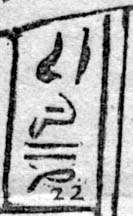 Detail of Figure No. 21 |
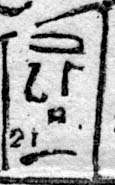 Detail of Figure No. 20 |
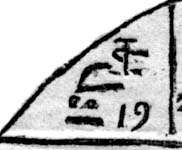 Detail of Figure No. 19 |
|---|---|---|
| "Behold thou art ever" | "as this god of thine" | "in(of) Busiris" |
Rhodes gives the following translation: "You shall ever be as that God, the Busirian."[1]
Notes
References
- Rhodes, Michael D. "The Joseph Smith Hypocephalus . . . Twenty Years Later" (PDF). Archived from the original (PDF) on 3 November 2006. Retrieved 15 March 2014.
- British Museum Dept. of Egyptian Antiquities, A General Introductory Guide to the Egyptian Collections in the British Museum, Published by Trustees of the British Museum, 1971, p.146
- William Matthew Flinders Petrie, Edward Russell Ayrton, Charles Trick Currelly, Arthur Edward Pearse Brome Weigall, Abydos, 1902, p.50
- Geraldine Pinch, Magic in ancient Egypt, University of Texas Press, 1995, p.157
- Alfred Wiedemann, Religion of the Ancient Egyptians, 2001, p.306
- Alfred Wiedemann, Religion of the Ancient Egyptians, 2001, p.306
- E. A. Wallis Budge, (1893), Mummy: A Handbook of Egyptian Funerary Archaeology, Kessinger Publishing 2003, p.476
- The Mummy A Handbook of Egyptian Funerary Archaeology, E. A. Wallis Budge, Second Edition Reprint, pgs. 476-477
- http://www.friesian.com/egypt.htm, The Pronunciation of Ancient Egyptian
- Ritner, Robert Kriech. The Joseph Smith Egyptian Papyri: a Complete Edition ; P. JS 1-4 and the Hypocephalus of Sheshonq. The Smith Pettit Foundation, 2013. page 268
- The Three Facsimiles from the Book of Abraham (1980), Hugh Nibley
- Smith, Joseph; The Book of Abraham: Facsimile No. 2: Explanation - available on Wikisource and on churchofjesuschrist.org
- Rhodes, Michael D. "Joseph Smith Hypocephalus". www.lightplanet.com.
- Nibley, Hugh, et al. One Eternal Round. Deseret Book, 2010. pg. 269
- Quoted here: https://books.google.com/books?id=UEgOAAAAIAAJ&pg=PA515
- Quoted and attributed here: http://user.xmission.com/~research/mormonpdf/hypocephalus3.pdf
- "Blogger: User Profile: I began to reflect". www.blogger.com.
- Sederholm, Val. "Restoring the Right Panels on LDS Book of Abraham Facsimile 2 (New Translations)". Retrieved 21 September 2016.
External links
